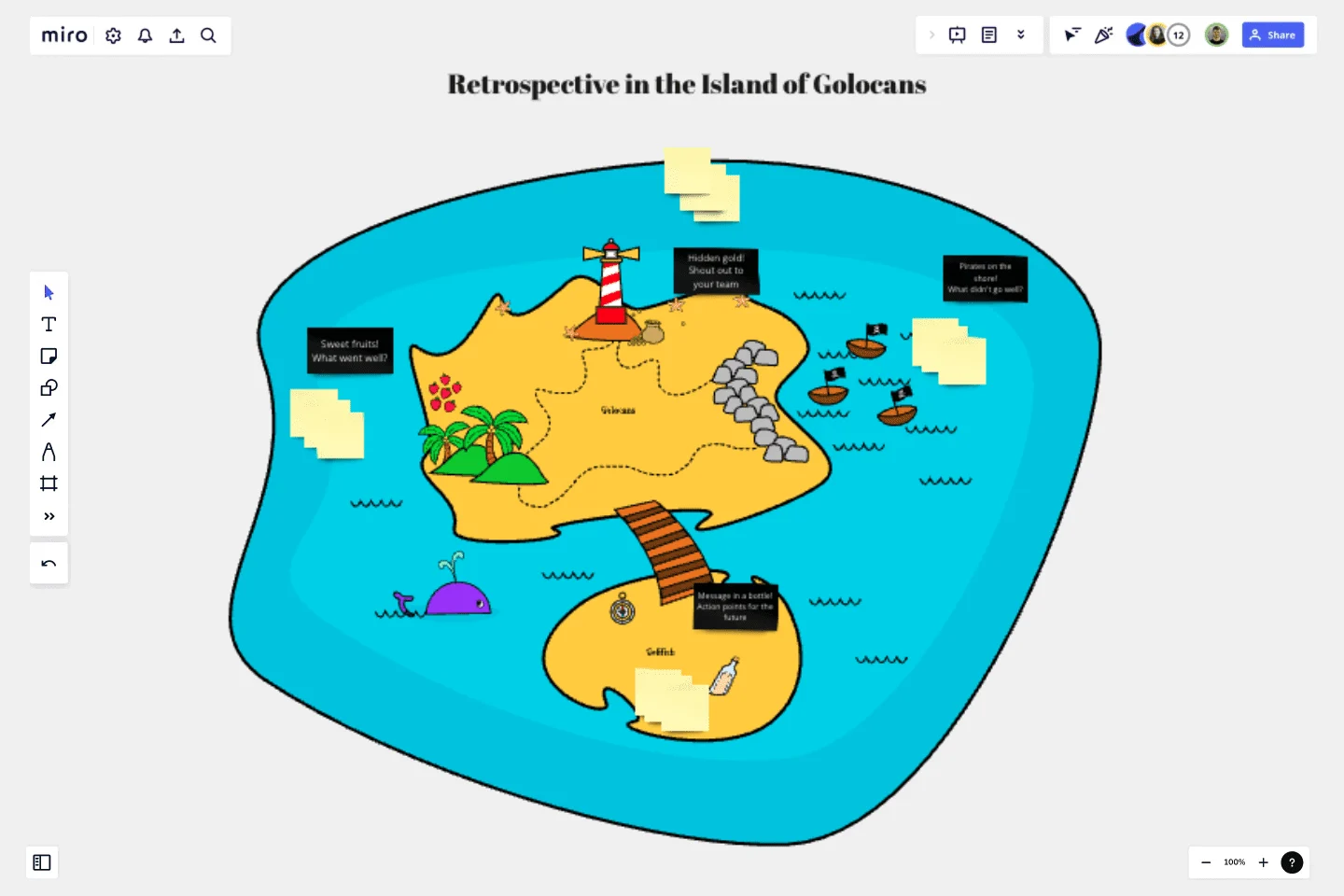Retrospective in the Island of Golocans
The Island of Golocans has four very unique characteristics. Run a effective retrospective with it.
The Island of Golocans has four very unique characteristics. The West has an abundance of sweet fruits, green hills and plenty of trees for some shade during peak summer. Apparently, the North of this island has some hidden gold coins near a lighthouse. In this region, one might spot plenty of starfish, too. The East coast is notorious for invading pirates - not all of them make it through the rough seas, though. The few that make it have to then climb up very uncomfortable rocks and only then will they be able to enter this island. Finally, the South Island, which is also known as Golifish, is connected with a wooden bridge. This region is very popular with voyagers who often come here and leave notes in glass bottles for future readers. They often also leave items of significance, like a compass, for guiding their journey to this island.
When performing a retrospective on the Island of Golocans, remember to cover all four directions:
Sweet fruits! What went well during the last sprint? Add a post-it note with your thoughts and celebrate your wins.
Hidden gold! Give your team a shout-out for the amazing work they've been putting in, the nuggets of information they provide, and for just being an awesome person to work with.
Pirates on the shore! This doesn't sound good, does it? Recall what didn't go well in the last sprint and write them down on each post-it note.
Message in a bottle! Record action points for the future. If you've thought of actionable items you and your teammates could work on to ensure that things can be better in the next sprint, make a note of them. If you have general ideas that can be implemented in the next sprint, make a note of them, too!
Have a pleasant time exploring this island!
This template was created by Clyde D'Souza
Explore all Miro's tool for online retrospectives and run more engaging and inclusive retros.
Get started with this template right now.
4Ps Retrospective
The 4Ps Retrospective template offers a structured framework for teams to reflect on past iterations or projects using the 4Ps model (Praise, Problems, Possibilities, and Plans). It provides elements for sharing positive feedback, identifying challenges, exploring opportunities, and setting action plans. This template enables teams to conduct retrospectives systematically, generate actionable insights, and drive continuous improvement. By promoting a balanced and comprehensive approach, the 4Ps Retrospective empowers teams to enhance collaboration, boost morale, and achieve their objectives effectively.
Lean Inception
Works best for:
Agile, Meetings
Lean Inception is a collaborative workshop for aligning teams on project goals and scope. It provides a structured framework for defining the product vision, user personas, and feature prioritization. This template enables cross-functional teams to collaborate, validate assumptions, and establish a shared understanding of the project vision and objectives. By promoting early alignment and customer-centric thinking, Lean Inception empowers teams to kickstart projects with clarity and purpose, driving efficiency and innovation from the outset.
Quick Retrospective Template
Works best for:
Education, Retrospectives, Meetings
A retrospective template empowers you to run insightful meetings, take stock of your work, and iterate effectively. The term “retrospective” has gained popularity over the more common “debriefing” and “post-mortem,” since it’s more value-neutral than the other terms. Some teams refer to these meetings as “sprint retrospectives” or “iteration retrospectives,” “agile retrospectives” or “iteration retrospectives.” Whether you are a scrum team, using the agile methodology, or doing a specific type of retrospective (e.g. a mad, sad, glad retrospective), the goals are generally the same: discovering what went well, identifying the root cause of problems you had, and finding ways to do better in the next iteration.
Kanban Framework Template
Works best for:
Kanban Boards, Agile Methodology, Agile Workflows
Optimized processes, improved flow, and increased value for your customers — that’s what the Kanban method can help you achieve. Based on a set of lean principles and practices (and created in the 1950s by a Toyota Automotive employee), Kanban helps your team reduce waste, address numerous other issues, and collaborate on fixing them together. You can use our simple Kanban template to both closely monitor the progress of all work and to display work to yourself and cross-functional partners, so that the behind-the-scenes nature of software is revealed.
Daily Stand-up Meeting Template
Works best for:
Agile Methodology, Meetings, Software Development
The entire team meets to review the day before and discuss the day ahead. These daily meetings, also known as “scrums,” are brief but powerful — they identify roadblocks, give each team member a voice, foster collaboration, keep progress on track, and ultimately keep teams working together effectively. This template makes it so easy for you to plan daily standups for your sprint team. It all starts with picking a date and time, creating an agenda, and sticking with the same format throughout the sprint.
Penny Game
Works best for:
Agile
The Penny Game is a simulation exercise that illustrates the impact of batch size and work in progress on cycle time and throughput. By tracking the flow of pennies through a production system, teams learn how to identify bottlenecks, optimize processes, and improve efficiency. This template offers a practical way to explore Lean principles and drive continuous improvement, empowering teams to streamline their workflow and deliver value more predictably.
